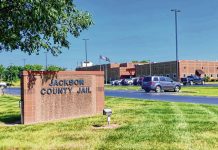Columbus residents are hearing more train whistles at night and fewer during the day.
That schedule change was implemented by Louisville and Indiana Railroad and CSX Transportation to enable daytime work crews to make improvements to rail lines near Seymour that will allow for longer, faster and more frequent trains, said John Goldman, Louisville and Indiana president.
Many of the trains that normally would come through Columbus during the day are now passing through during the evening hours — sometimes as late as 10 or 11 p.m. — so that they do not interfere with the work on the southern Indiana lines, Goldman said.
Daytime train traffic through Columbus has not been eliminated, however, as some commuters still find themselves stalled by slow-moving trains during the morning rush hour and at other points throughout the day.
[sc:text-divider text-divider-title=”Story continues below gallery” ]
Such train-related traffic delays will increase in Columbus as CSX’s work on the rail lines moves north from Seymour, but that impact likely won’t be felt for months.
What’s ahead
Right now, about two to three CSX trains travel through Columbus each day, but the track upgrade — approved by the federal government — will allow for up to 15 trains per day, said John Dorenbusch, vice president of the Columbus Redevelopment Commission and leader of the Railroad Community Committee.Dorenbusch said he has seen new rails lying near the existing rail lines in Columbus as CSX prepares to replace the rails.
After the lines are improved through Columbus, longer trains — up to 7,500 feet — also will run through the city at speeds up to 49 miles per hour, compared to the current speed limit of 25 miles per hour.
CSX announced that motorists in the areas between Seymour and Butlerville, south of Columbus, will begin to notice a change in the local train traffic as soon as Wednesday. That’s when the transportation company will begin running longer and faster trains — up to 40 miles per hour — more frequently as a compliment to its planned upgrade of the Louisville & Indiana rail lines.
For now, trains coming into Columbus will have to slow down to the current speed limits as CSX works to replace the bridge over the Flat Rock River in Columbus, Dorenbusch said.
Right now, that bridge is neither tall enough nor strong enough to accommodate the double-stack container trains CSX would like to move on the rail lines, Columbus Mayor Jim Lienhoop said.
The bridge is scheduled to be replaced in the second quarter of 2017, with the increase in local train traffic likely following closely behind, Lienhoop said.
For now, some Columbus residents say the current train traffic is already a hindrance to their daily travels throughout the city.
Jean Coffman, who lives on the city’s west side, said she generally gets caught in train-related traffic back-ups along State Road 46 one or two times a month, often for around five minutes at a time.
While such delays are not usually a huge inconvenience to Coffman, she said they can be frustrating, especially if she is in a hurry.
But when the increase in the number of trains hits Columbus, Coffman said she is already worried about the effect the extra trains will have on her daily commute.
“That will hold up a lot of traffic,” she said.
Impact study
In the meantime, the city is moving forward with its studies of current traffic patterns to determine the impact from the increase in trains.American Structurepoint has been hired by the city as the railroad project consultant, studying traffic data at six key railroad crossings throughout the city:
County Road 200 South
Spear Street
State Roads 11 and 46
Fifth Street
Eighth Street
11th Street
Structurepoint’s efforts have been particularly focused on the crossing at State Roads 46 and 11 just east of the downtown because the city usually sees the largest train-related traffic back-ups at that crossing, Dorenbusch said.
Residents have complained of being backed up on State Road 46 due to passing trains all the way to the shops along Merchant’s Mile. Coffman said she has been caught in those back-ups herself.
Structurepoint is also studying the intersections of State Road 46 with Carr Hill Road and Johnson Boulevard, two areas with lots of retails shops and where heavy traffic congestion is common, Dorenbusch said.
While the consultant is studying the city’s traffic patterns and how they might be affected by more trains, Dorenbusch said he and others involved in the railroad project are searching for ways to garner financial support for what he said will likely be a costly fix to the train problem in Columbus.
Competing for funding
Several other cities throughout Indiana will be affected by the Louisville & Indianapolis expansion, and all of those cities will likely be competing for help and finances from the Indiana Department of Transportation, Dorenbusch said. In order to get INDOT’s attention, the city will have to prove that its train traffic problems will be worse than elsewhere in the state.The city already has an advantage in that respect with its current traffic level of service at the crossing at state roads 11 and 46, the commissioner said.
Level of service measures traffic flow in specified areas on an A-F scale depending on how freely traffic moves through the area. Areas with lower scores tend to get INDOT’s attention more easily than those with better scores, Dorenbusch said.
At the part of the crossing where Third Street becomes State Road 46, Dorenbusch said the level of service is a Grade D only because the traffic is free-flowing across the tracks.
But at the point where Third Street becomes State Road 11, Dorenbusch said the level of service is a Grade F because motorists are forced to stop at a light before crossing over to the state road.
With levels of service already so poorly graded, Dorenbusch said it could be easier to get help from INDOT when the train traffic increases.
Dorenbusch said building an overpass over the crossing at State Road 46 seems to make the most sense, although cost estimates are premature.
“You can’t go under the railroad, and the railroad is not going to raise itself, so the only thing you can do is go over it,” he said.
When the city makes a decision on the best way to handle the increased train traffic, Dorenbusch said it will begin actively pursuing INDOT funding.
But aside from convincing INDOT to take on Columbus’ case, the commissioner said there are also political considerations that could impede the city’s efforts toward avoiding excessive traffic back-ups.
The November election will bring a new governor to Indiana, replacing current Gov. Mike Pence, the Columbus native who is running for vice president on the national Republican ticket.
Having a native sitting in the governor’s office would have likely worked to the advantage of Columbus as the city tries to find a solution to the train problem, Dorenbusch said, but such a political advantage Columbus might have had no longer exists.
“Our best friend is going to be gone, and that is not going to help us,” he said.
[sc:pullout-title pullout-title=”What’s next” ][sc:pullout-text-begin]
The Railroad Community Committee will likely have its next public meeting at Columbus City Hall this month, although an exact date has not been set, committee leader John Dorenbusch said. That meeting will focus on the data American Structurepoint, Inc. has gathered in its study of local traffic patterns, as well as discussions about potential ideas for avoiding excessive train-related back-ups.
All public city meetings are listed on the city’s website at columbus.in.gov under the “Calendar” tab.
[sc:pullout-text-end]




